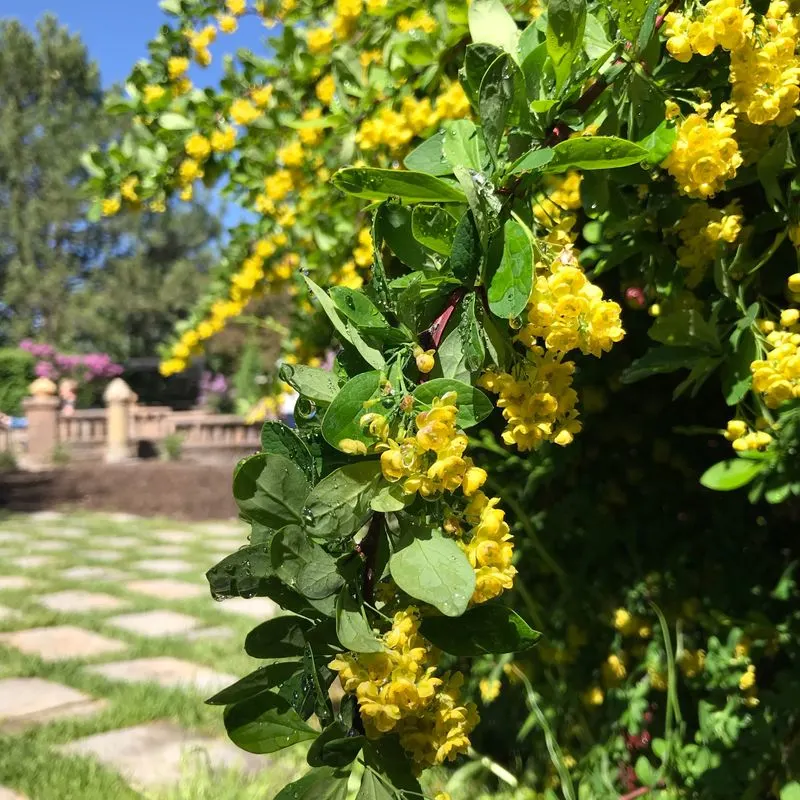As the chill of winter sets in, many gardens lose their vibrancy, transforming into a palette of browns and grays.
Yet, evergreen mahonia stands as a beacon of color and resilience, making it an enchanting choice for those seeking to add life to their winter landscapes.
With its striking holly-like leaves and clusters of bright yellow flowers, mahonia offers a touch of elegance and brightness even in the coldest months.
Here, we explore nine captivating aspects of this evergreen marvel that make it an essential addition to any winter garden.
Vivid Yellow Blooms

Mahonia’s vivid yellow blooms are a true spectacle during winter, contrasting beautifully with the season’s typical muted tones. These flowers not only brighten the garden but also attract pollinators like bees, who are drawn to their sweet nectar.
The clusters of yellow blossoms appear in late fall and can last well into winter, providing continuous color. Their striking appearance is complemented by a gentle fragrance that can uplift the dreariest of winter days.
For gardeners aiming to add color, mahonia’s blooms are a reliable and stunning choice, requiring minimal maintenance while offering maximum impact.
Holly-like Foliage

Mahonia’s foliage mirrors that of holly, with its glossy, spiky leaves adding texture and interest to the garden year-round. This unique feature makes it a standout plant, even when not in bloom.
The rich, dark green leaves provide a perfect backdrop for its flowers and can turn a beautiful shade of bronze or purple in colder temperatures. This seasonal color change adds another layer of visual appeal.
Beyond aesthetics, these hardy leaves are also resistant to many pests and diseases, offering a robust option for gardeners seeking both beauty and resilience.
Year-Round Appeal

Mahonia’s charm is not limited to one season; its year-round appeal makes it a versatile addition to any garden. The plant’s ability to provide vibrant color and structure throughout the year is unmatched.
In spring and summer, its lush foliage offers a verdant backdrop, while autumn and winter bring out its flowering phase. This continuous cycle of visual interest keeps the garden engaging and lively.
For those looking to maintain a dynamic landscape without the need for constant replanting, mahonia is an ideal choice, offering beauty and structure in every season.
Low Maintenance Requirements

One of mahonia’s most appealing traits to gardeners is its low maintenance nature. This hardy plant thrives in a variety of conditions, from partial shade to full sun, and is adaptable to different soil types.
Its drought tolerance and pest resistance mean it requires little intervention once established. Occasional pruning is usually sufficient to maintain its shape and encourage healthy growth.
For busy gardeners or those new to gardening, mahonia offers a worry-free option that doesn’t sacrifice beauty or impact, making it easy to enjoy a stunning winter garden with limited effort.
Wildlife Magnet

The vibrant flowers and dense foliage of mahonia make it a magnet for wildlife, especially in the colder months when food sources are scarce. Birds are attracted to its berries, while bees and other pollinators visit its flowers.
This interaction not only supports local ecosystems but also brings life to the garden, offering a dynamic and lively environment. Observing these creatures can be a delightful experience for any garden enthusiast.
By planting mahonia, gardeners can contribute to biodiversity, supporting wildlife and enjoying the bustling activity it brings to their winter garden.
Unique Textural Contrast

Mahonia adds a unique textural contrast to any garden composition. Its bold, leathery leaves stand out against softer, more delicate plants, adding depth and interest to the landscape.
This contrast can be used strategically to create focal points or to complement other plants with varying textures and colors. The interplay between the rugged mahonia and more gentle foliage can create a visually stimulating garden.
For those looking to design a garden with complexity and charm, mahonia’s distinctive texture is a valuable asset, elevating the overall aesthetic of the space.
Cold Hardy Resilience

Mahonia is renowned for its cold hardiness, thriving even in harsh winter conditions where many other plants falter. Its ability to withstand frost and snow makes it a reliable choice for winter gardens.
This resilience ensures that the garden remains vibrant and engaging throughout the coldest months, providing a steadfast source of beauty. It’s an excellent option for regions with challenging winter climates.
By choosing mahonia, gardeners can enjoy a robust and enduring garden, even when temperatures drop, ensuring that their outdoor space remains inviting and alive.
Versatile Landscaping Options

The versatility of mahonia makes it suitable for a wide range of landscaping styles, from formal gardens to naturalistic settings. Its adaptability allows it to fit seamlessly into different design schemes.
It can be used as a standalone focal point, planted in groups for a bold statement, or integrated into a mixed border. Its presence can enhance the overall aesthetic and functionality of the garden.
For landscape designers and home gardeners alike, mahonia offers endless possibilities, providing both structure and beauty in diverse settings. Its adaptability ensures it complements any garden style.
Historical and Cultural Significance

Mahonia holds historical and cultural significance in various regions, often associated with traditional medicine and ornamental gardening. Its use dates back centuries, where it was valued for both its beauty and utility.
In addition to its horticultural appeal, mahonia has been used in herbal remedies, believed to offer health benefits. This rich heritage adds a layer of intrigue and appreciation for the plant.
For gardeners interested in plants with a story, mahonia provides a connection to the past, enriching the garden with historical depth and cultural resonance that extends beyond its visual allure.

